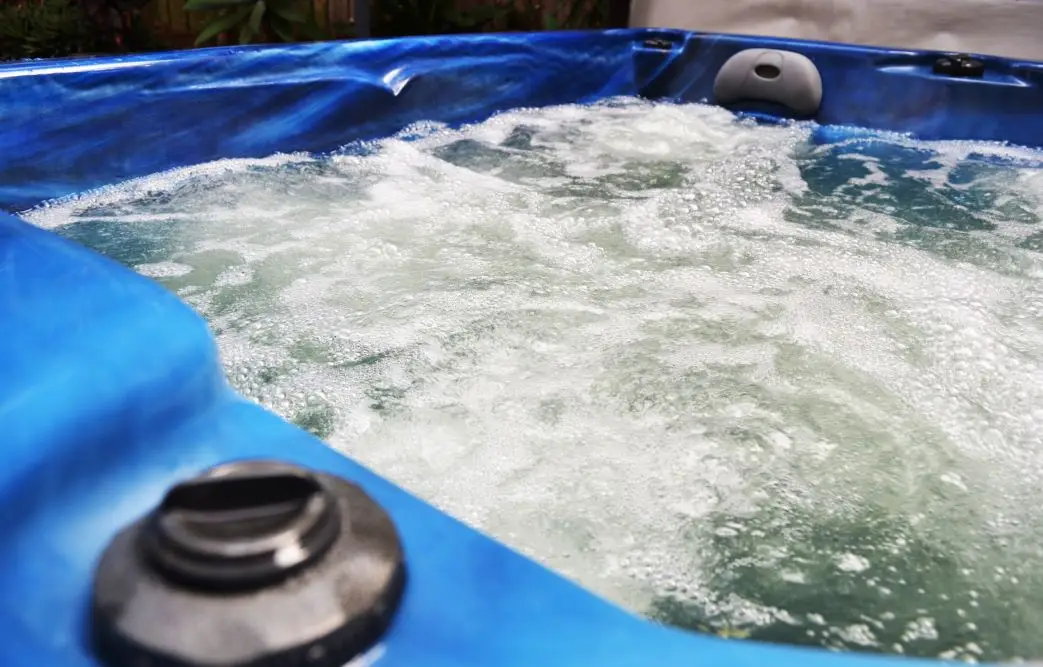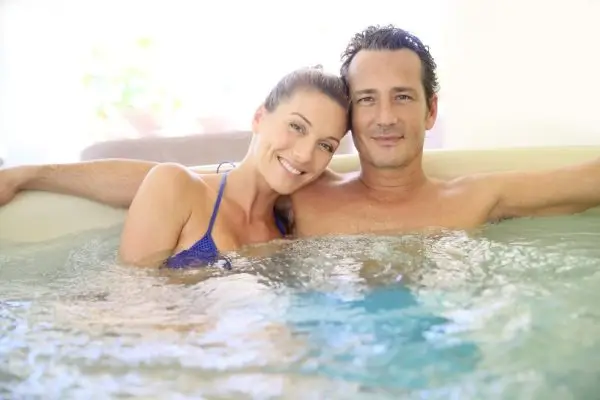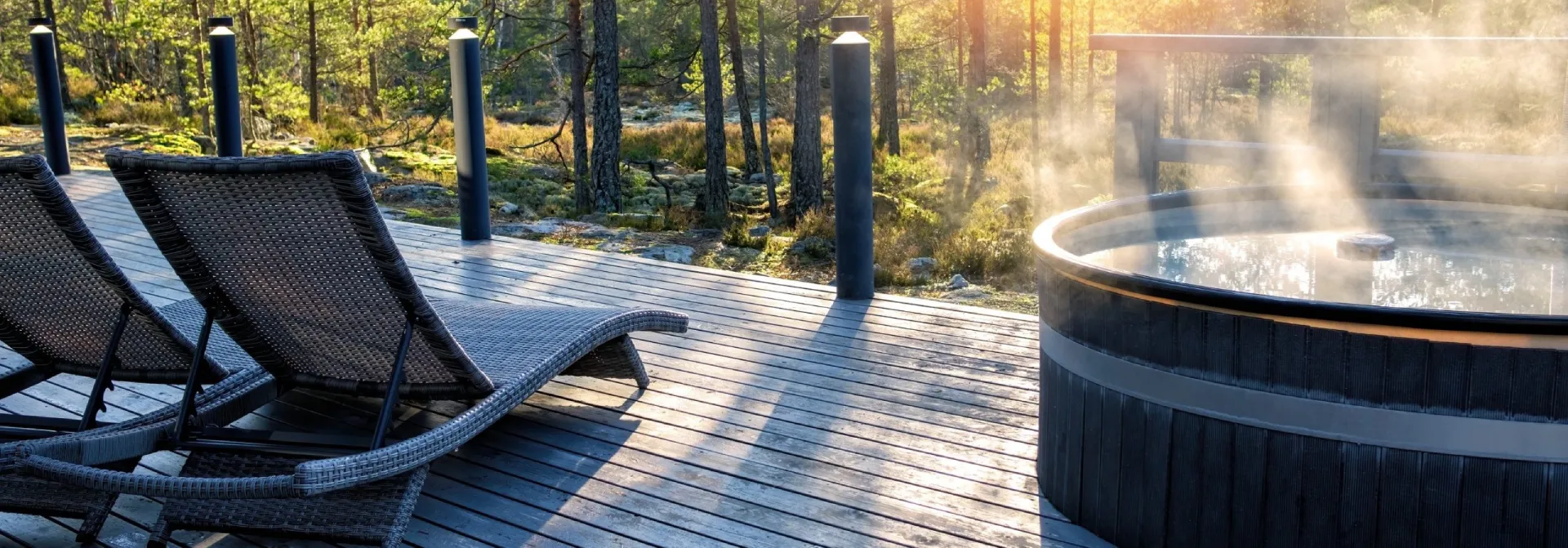Importance of Regular Hot Tub Maintenance
Have you ever wondered how hot tub spa water remains clean and safe for use? That’s one major concern for tub owners. Of course, we don’t want to dip in water contaminated by different elements. Cleaning and treating the water is one important aspect of maintenance. This process removes body oils, bacteria, and other contaminants in the water.
Another advantage of proper maintenance is it extends the lifespan of your hot tub. Hot tubs have a life expectancy of 5 to 20 years, depending on the brand. If I have a hot tub, I want it to last me a long time so I can maximize its utility. To do that, I must quickly fix any issues and keep the components clean and well-maintained. It’s a clever way to avoid costly repairs and premature wear and tear.
Lastly, we want our hot tub always to run efficiently. Proper maintenance helps address that. We’re all after saving money on energy and water bills, right? Our hot tub will operate at its best if we maintain pH levels, calcium hardness, and other chemical levels within the proper range.
What Type of Maintenance Do Hot Tubs need?
Hot tub maintenance comes in different forms to keep them in optimal condition. Regular cleaning of filters ensures proper water flow by removing debris. Skimming and vacuuming eliminate leaves, dirt, and particles from the water. Cleaning the cover regularly protects the hot tub from UV rays and debris.
Protecting Your Investment
Have you heard someone say, “Maintenance is always cheaper than repair”? This claim is true for almost everything, including hot tubs. Preserving its quality is vital for protecting the investment you’ve made. Again, hot tubs aren’t cheap, and we want them to remain in good working condition as well as prevent issues that could potentially void their warranty. I’d rather spend a few bucks now for certain supplies I need for maintenance than pay a lot of money for expensive repairs in the future.
What is in a Hot Tub Maintenance Plan?
A hot tub maintenance plan typically includes proper water care, regular filter maintenance, and routine cleaning. Regular testing and treatment of the water helps maintain proper chemistry, making it safe for bathing. Other tasks, such as cleaning the hot tub cover, spa shell, and filter, are also an essential part of the maintenance routine.
1. Water Care
If I’m to take a dip in a hot tub, my first question is, “Is it clean”? Water care is a first maintenance task that you shouldn’t compromise. Monitor the pH level regularly and adjust it as necessary using pH increasers or decreasers. Shock treatments and the use of hot tub chemicals are the key to preventing the buildup of bacteria, algae, and other contaminants. I make sure I have these supplies on hand for my tub maintenance. Changing water regularly and balancing of calcium hardness and sanitizer levels are also ways to keep spa water fresh, clean, and inviting.
2. Cleaning
Clean the tub, too, not only the water. My tip is to use a mild cleaner instead of harsh chemicals that can damage the surface of your hot tub. Don’t forget to include cleaning and replacing the filter to ensure proper water circulation and filtration. After 3 to 4 months, drain and refill the hot tub to keep the water fresh.
3. Filters
As part of hot tub maintenance, pay close attention to filters, as this improves water circulation. You should also Inspect and maintain the cover to prevent heat loss and debris buildup in the tub. If you like in colder climates, protect the hot tub from freezing temperatures and damage. All these minor tasks are part of your maintenance routine.
5 Step Process
- Planning Plan ahead and create a hot tub maintenance checklist
- Daily Routine Check the PH and Alkalinity daily
- Weekly Routine Clean the filter and the hot tub
- Monthly and Quarterly Drain and clean
- Water Circulation Run the pump daily to maintain the circulation
The 5 Step Hot Tub Maintenance Process
The key to hot tub maintenance is keeping the water clean and balanced. Regularly clean your filter to maintain good water quality and prevent debris buildup. Skim and vacuum the water surface to free it from dirt and leaves. Treat the water with proper chemicals to ensure the right pH level and water chemistry.
Don’t forget to clean your hot tub cover regularly to protect it from the elements. Maintain alkaline levels and periodically clean the filter for proper water flow. Routine maintenance includes skimming, vacuuming, and cleaning the waterline. Check sanitizer levels and follow a maintenance schedule to stay on track with your hot tub care.
1. Planning
Since maintenance is kind of demanding, a routine must be in place to maximize your time and energy. You can divide the tasks into daily, weekly, monthly, and quarterly schedules. I stick to this routine on my own, which helps me monitor which tasks I should be doing at a certain time.
2. Daily Routine
Test the water chemistry daily to maintain proper levels of sanitizer, pH, and alkalinity. This step keeps your spa water balanced and free from harmful bacteria. I usually do this after I skim the water surface to remove any debris like leaves or body oils. Then, you can check the water levels and top up if necessary. These tasks are pretty simple and won’t take so much of your time.
3. Weekly Routine
Shock your hot tub water on a weekly basis as part of the routine to maintain optimal water quality. Include cleaning your hot tub filter. I had an experience before when I had difficulty eliminating body oils, debris, and other particles in the water. Later, I realized that the filter was clogged, so I made sure to check from then on. You can also use a water clarifier to make hot tub water clear and sparkling. Before leaving the tub, inspect the tub cover, spa cover, and spa vacuum for any issues that may need attention.
4. Monthly and Quarterly Tasks
Draining and refilling the spa water should be done every 3 to 4 months. Yes, you don’t have to do that every bath as long as you’ve done the other daily and weekly tasks I’ve mentioned. It helps remove the buildup of body oils and contaminants. Take this time also to clean the tub. Then, inspect the jets, pumps, heaters, and other parts of your hot tub for any signs of damage or wear. Lastly, balance the total alkalinity levels to avoid any water quality issues.
5. Water Circulation
On top of all the tasks mentioned above, let me reiterate the importance of water circulation. Running the pump for a few minutes each day helps circulate the water thoroughly, preventing stagnant areas. Doing so helps achieve the right balance of chemicals, prevent cloudy water, and ensure clean water in your tub.
How to Clean Your Spa Filters
Since I’ve mentioned the importance of cleaning hot tub or spa filters, I will give here basic cleaning steps. If you have the manual or guide from your manufacturer, make sure you check that first for specific instructions. Some filters may require a different cleaning process.
1. How Does A Hot Tub Filter Work?
Hot Tub filters work by trapping dirt, debris, and organic matter, preventing them from recirculating in the water. Because of its function, filters are prone to clogging as they trap more and more elements in your tub.
2. Rinse
The first step is to rinse the filter to remove loose debris and particles that were trapped in it. I usually use a garden hose to carry out this process. Just ensure water flows through all filter parts, especially the hard-to-reach areas. After cleaning the filter with a cleaner solution, rinse it again to eliminate any residue.
3. Spray
Sprucing up your hot tub filter goes beyond a simple water rinse. You’ll need to spray it with appropriate chemicals to achieve a deeper clean. These chemicals are meant to eliminate stubborn contaminants and other impurities that regular rinsing may not entirely remove.
4. Soak
Another step is to soak your hot tub filter in a cleaning solution recommended by your manufacturer. Most recommendations say you soak it for at least 12 hours and up to 24 hours. I usually do a 24-hour or overnight soak, and the filter’s been doing fine so far.
5. Harmful Ways to Clean A Filter
While using bleach or chlorine tablets for a quick clean may be tempting, these can damage the filter material. So, I don’t recommend this to you. Similarly, avoid using high-pressure water or abrasive brushes as they can cause tears or holes in the filter fabric. Household cleaning products like dish soap or laundry detergent aren’t designed for hot tub filters and should never be used. Even if you’re trying to cut costs, using these inappropriate chemicals will only compromise water quality and reduce the effectiveness of your filter. Stick to proper cleaning techniques and products recommended by your hot tub manufacturer, and you’ll have no problem.
6. Drain and Clean Your Hot Tub
Refer to the instructions provided by the manufacturer on properly draining your hot tub. I use a submersible pump to remove the water efficiently. Once drained, use appropriate cleaning products to clean the shell, cover, and accessories thoroughly. Refill the hot tub with fresh water and balance the water chemistry after cleaning.
Can Regular Maintenance Extend the Life of Your Hot Tub?
It does. A regular maintenance practice prevents issues that may arise in the future. You can avoid costly repairs or replacements and ensure its functionality for years to come. It also helps you identify malfunctions early on and carry out quick solutions to prevent further damage.
The Role of Preventive Care in Extending Hot Tub Life Span
Preventative care identifies and addresses issues in your hot tub before they become significant problems. Proper water chemistry maintenance, including checking the pH level and using the right chemicals, can prevent issues that may damage your hot tub’s components. Additionally, cleaning the spa filters and ensuring clean water circulation is essential for keeping your hot tub in good working condition. Consistent care of your hot tub’s water quality, such as changing the water regularly and using shock treatment when necessary, can prolong its life span.
Frequently Asked Questions
Can I perform hot tub maintenance myself, or should I hire a professional?
Performing hot tub maintenance yourself is possible, but it requires regular attention and care. We recommend hiring a professional if you lack experience or are uncomfortable with the process. They can ensure your hot tub remains safe and properly functioning. Refer to your manufacturer’s guidelines for self-maintenance or hiring a professional.
What are some common signs that my hot tub needs maintenance?
Common signs that your hot tub needs maintenance include cloudy or discolored water, foam or scum on the surface, unusual odors, and strange sounds. Paying attention to these signs will help you ensure your hot tub’s proper functioning and longevity.
Conclusion
More Articles That May Interest You

Hot Tub Filter Has No Suction!
Many hot tub owners tend to neglect their filters, causing them to become extremely dirty and sometimes not usable. This will lead to the malfunction of the filters.

3 Tips On How To Soundproof a Loud Hot Tub Motor
There are two possible reasons why you would want to soundproof a loud hot tub motor. You are either annoyed by the neighbor’s hot tub ....

20 Most Helpful Hot Tub Maintenance Apps
Whether you are the proud owner of a shiny new hot tub or already own one, you might be wondering ....
What We Do - Who We Help
The Hot Tubs Report: Your Ultimate Guide to All Things Hot Tub
The Hot Tubs Report is your ultimate guide to all things hot tub-related. Maybe you’re a seasoned owner or simply considering purchasing one, this comprehensive resource has got you covered. It covers tips on maintenance and troubleshooting all the way through to the latest trends in hot tub technology. It is all here at your fingertips. Take the chance and dive into our expert advice and discover how owning a hot tub can enhance your lifestyle and provide endless relaxation.


Why Choose Us
Years of Experience Condensed into One Location
Are you ready to take your relaxation game to the next level? You have come to the right place! Hot Tub Reports provides answers and insights to both Hot tub owners and those thinking of taking the plunge and buying one. We want to answer some of the quirky and interesting questions that we had when we first purchased a hot tub. If you’re a new tub owner or are planning to get one, you must read these reports. We’ve compiled everything you need to know to make your experience match your dreams based on our years of experience.

